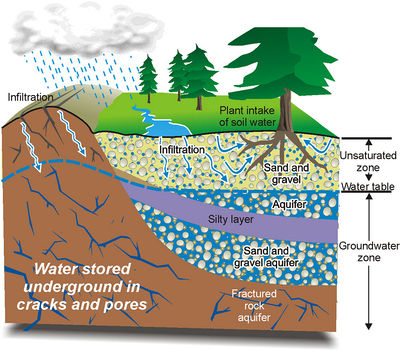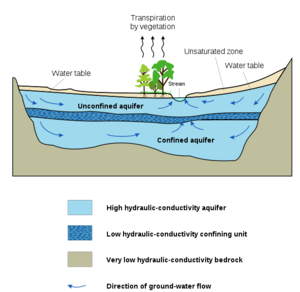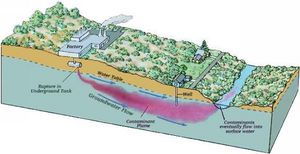Groundwater
Introduction
Surface water moves downward through unsaturated zones –typically tiny pores and cracks in the soil, sand, or rock, and then reaches a stable and completed water saturated layer named water table. Groundwater is beneath the water table. Groundwater provide about 0.6 percent of the world’s total water and 20 percent of the available fresh water resources. Microbial organisms play important role in groundwater ecosystem and affect drinking water quality significantly. Microbial contamination of groundwater is a big concern.
Physical environment
Substrate and sediment
In the shallow aquifers where generally groundwater is located, typically, there is soil, sand, plant roots, hardpan and low permeability bedrock.
Temperature
The temperature of groundwater is quite steady because the specific heat capacity of water is high and also because the soil, rock and up layer water protect groundwater from heat changing with the climate.
Hydrogeology
Groundwater is relatively stable compared to surface water. In the aquifer and other porous media, groundwater not only follows gravity, but also follows pressure gradients. The movement of groundwater also depends on the porosity, water content and hydraulic conductivity of aquifer.
Groundwater contamination
Pollutants, such as gasoline, oil, road salts and chemicals seep into groundwater can hurt animals, plants, or humans. Two major contaminate sources are Hazardous waste site leaking and landfills. Since groundwater is part of hydrologic cycle, contaminates released to the groundwater could create a contaminant plume within an aquifer and also can be transferred to the other parts of the cycle.
Microorganisms
Bacteria
Gram-negative bacteria are found extensively in groundwater system. Balkwill (1989) studied the aerobic, chemoheterotrophic bacteria in deep aquifers and other subsurface sediments at a site in South Carolina. They found that 95% of the platable colonies contained nonstreptomycete bacteria, more than 80% of which were gram-negative rods. Gram-positive bacteria are not many in groundwater system; however, the gram-positive bacteria include many important human pathogens such as micrococcus, staphylococcus, and streptococcus.
Virus
It is estimated that 65% of the water borne disease are caused by enteric viruses. For example, norovirus (also known as Norwalk agent) causes approximately 90% of epidemic non-bacterial outbreaks of gastroenteritis around the world. Infectious hepatitis is the most intensively studied disease that is caused by water borne virus. Virus adsorption to soils and other solids could prolong survival of viruses in the groundwater. Research showed that Viruses originating from wastewater infiltration units are able to migrate horizontal in groundwater for hundreds of meters and vertically as great as 67 meters.
Eucarya
Groundwater eukaryotes are comprised of many species, range from single-celled heterotrophic nanoflagellates and fungi to amphipod crustaceans. The location of groundwater eukaryotes might be close to the vadose (unsaturated) zone, the soil or the bottom sediments of surface waters.
Archaea
Groundwater Archaea have been found throughout depths of several thousand meters. Ammonia-Oxidizing Archaea and methanogenic Archaea are two major groups in the groundwater.
Microbial processes
What microbial processes define this environment? Describe microbial processes that are important in this habitat, adding sections/subsections as needed. Look at other topics in MicrobeWiki. Are some of these processes already described? Create links where relevant.
Eucarya
Subsection 1a
Subsection 1b
Subsection 2
Current Research
Enter summaries of recent research here--at least three required
References
Edited by <your name>, a student of Angela Kent at the University of Illinois at Urbana-Champaign.



